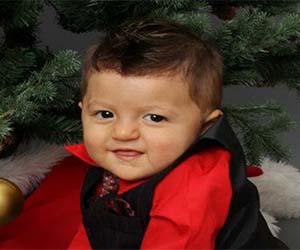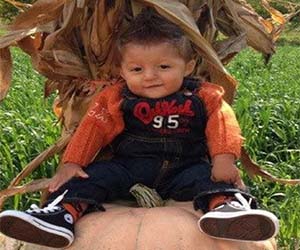 While we were pregnant with Jonathan everything was absolutely perfect, and in the last trimester I had never felt better. However, a month before Jonathan was due we were scared by an ultrasound that depicted an abnormality in the brain. We were heartbroken to think that after all this time something could be wrong. After weekly visits to a specialist, the results only remained the same and did not get worse. This made the doctors believe that everything was okay, and there would be nothing to worry about.
While we were pregnant with Jonathan everything was absolutely perfect, and in the last trimester I had never felt better. However, a month before Jonathan was due we were scared by an ultrasound that depicted an abnormality in the brain. We were heartbroken to think that after all this time something could be wrong. After weekly visits to a specialist, the results only remained the same and did not get worse. This made the doctors believe that everything was okay, and there would be nothing to worry about.
When Jonathan was born on July 15, 2011, he seemed to be a beautiful, healthy boy. Everything seemed normal in the first few months, but once he was about four months old, family members began to be concerned that he was not doing things that other babies would do. He was very quiet and not interested in toys or playing. After a month or so he was still not rolling or trying to sit up so we began to think something might be wrong. First, we went to a neurosurgeon who told us that he had very bad hypotonia, or low tone, that would make it more difficult for him to be active. He was given an MRI of the brain that showed there was a small amount of fluid, called Hydrocephalus. We thought that this was not the worst news because it could contribute to his developmental delays, but he could still live a normal life. Our doctor did not stop there. Jonathan began physical therapy and occupational therapy through Early Intervention, and was sent to an ophthalmologist, who diagnosed him with a bilateral astigmatism and a strabismus (a wandering eye). He would most likely need surgery to correct the wandering eye as well as eyeglasses in the future. Still, we thought that these diagnoses were not too bad for us to handle.
 As time went on and Jonathan was still receiving the physical and occupational therapies he was making some improvement, but still not achieving the basic milestones. He began rolling at 9 months old and sitting up independently at 14 months old. Seeing him struggle with these milestones was heartbreaking, and we knew that we had to get to the root of the problem. In November of 2012, Jonathan received a diagnosis from a genetic counselor. He was diagnosed with a rare genetic disorder called MeCP2 Duplication Syndrome in which that particular gene duplicated. This caused all of the delays in the developmental milestones, also causing the issues with his eyes and low tone. With this diagnosis, we were confronted by the fact that Jonathan will always struggle more than most children. His cognition and speech will be affected, and he can also be more at risk for respiratory infections and seizures. This disorder is so rare that doctors and geneticists will be learning more about the disorder from Jonathan. Although every day is difficult, Jonathan’s laugh and smile make people feel so warm and happy that it gives us the strength to keep going and find any possible way that we can to help him.
As time went on and Jonathan was still receiving the physical and occupational therapies he was making some improvement, but still not achieving the basic milestones. He began rolling at 9 months old and sitting up independently at 14 months old. Seeing him struggle with these milestones was heartbreaking, and we knew that we had to get to the root of the problem. In November of 2012, Jonathan received a diagnosis from a genetic counselor. He was diagnosed with a rare genetic disorder called MeCP2 Duplication Syndrome in which that particular gene duplicated. This caused all of the delays in the developmental milestones, also causing the issues with his eyes and low tone. With this diagnosis, we were confronted by the fact that Jonathan will always struggle more than most children. His cognition and speech will be affected, and he can also be more at risk for respiratory infections and seizures. This disorder is so rare that doctors and geneticists will be learning more about the disorder from Jonathan. Although every day is difficult, Jonathan’s laugh and smile make people feel so warm and happy that it gives us the strength to keep going and find any possible way that we can to help him.
